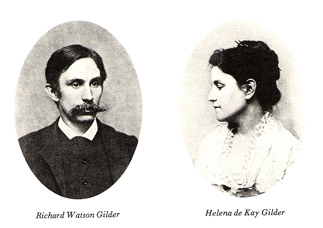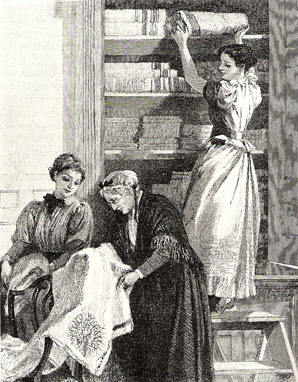Mary Hallock Foote
|
 |
|---|
"Molly [Mary Hallock Foote] met Helena at Cooper Union during the winter of 1866-67 and this was the beginning of their life long friendship. They came from different backgrounds, but their attraction to one another was instantaneous. Molly's memory of this encounter, expressed in lyrical prose years later, suggests its importance to the young artist: 'And then Helena dawned on my nineteenth year like a rose pink winter sunrise, in the bare halls of Cooper, sweet and cold after her walk up from the ferry. Staten Island was her home; a subsidiary aunt had taken me in that winter who lived on Long Island and I crossed by an uptown ferry and walked down. Across the city we came together and across the world in some respects.'
Ten months older than Molly, Helena was born into an old New York family...Her father died when she was only two years old, and in 1859 her widowed mother took the family to Europe, where they lived for a time in Dresden. There Helena learned French, German, and Italian and developed a passion for art. Later she attended a boarding school in Middleton, Connecticut, and then enrolled in painting classes at Cooper Union.
In the exhilarating atmosphere of the New York art world, Molly and Helena soon developed an intense relationship. Both then and years later, Molly called Helena the first great passion of her life...They wrote of their happiness when together and of their pain and loneliness when apart. And they openly avowed their love for one another, as when Molly wrote to Richard Gilder, Helena's fiance: 'Do you know sir, until you came, I believe [Helena] loved me almost as girls love their lovers. I know I loved her so.'

...In physical appearance, each young woman had pleasant features, and each wore her hair in a fashionable chignon. Helena was of average height, Molly somewhat shorter. Years later Helena wrote of her first impressions of Molly: 'very youthfull in figure, delicate and yet full of vigor. She rode well...She skated on her little feet like a swallow flying, and danced with the same grace and lightness. She could outskate and outdance us all.'
The tree years that Molly studied a Cooper Union were perhaps the happiest and most carefree of her life. The year she met Helena, however, was the most memorable of all. Helena was in the painting class and Molly was in drawing, but they attended anatomy lectures and Friday composition classes together...Molly still had in her possession years later a page on which Helena had copied a line from Shakespeare: 'Let me not to the marriage of true minds admit impediments.'
They spent afternoons at the School of Design, sometimes working on their sketches and paintings, oftentimes talking in vacant alcoves comparing our past lives and dreams for the future' Helena introduced Molly to the writings of new authors and thinkers and to new ways of viewing life. The very first book that she gave to Molly (in a lifetime of sharing books) was a volume of Emerson's poems. She also introduced Molly to the works of Matthew Arnold and John Stuart Mill, and together they pondered women's role in art and society.

Illustration by Mary Hallock Foote
They shared one another's friends and came to know one another's homes and families. Milton [Molly's hometown] charmed the New York City girl who had seen Europe, while the young Quaker never forgot the shared intimacy of Staten Island ferry rides...Molly wrote to Helena [years later] 'We have had our May day--darling! I believe very few girls knew better the joy of youth.' And much later, writing in her mid-sixties, Molly acknowledged her intellectual debt to Helena: 'Your mind has lead mine for a good many years,' and she referred to Helena as 'the strongest influence my life has known outside of its daily companions-- of flesh and blood."
from-"Mary Hallock Foote, Author-Illustrator of the American West" by Darlis A. Miller


 Edith Bonham, 1917. Foote's novel about Helena
Edith Bonham, 1917. Foote's novel about Helena 

